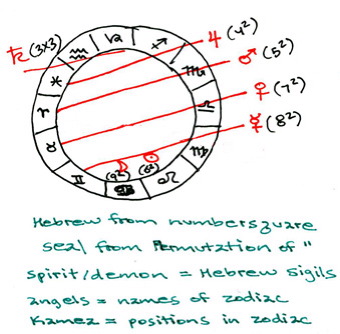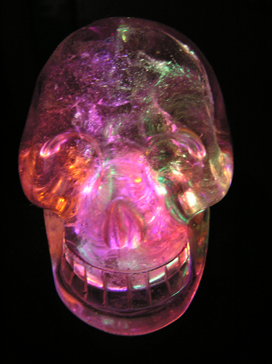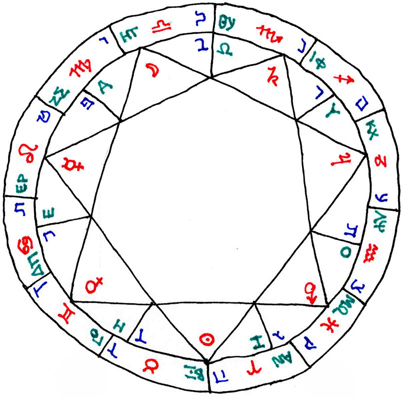instruments of the work:
 ^^^^^^^^^^^^^^^^^^^^
Click for full chart .jpg
^^^^^^^^^^^^^^^^^^^^
Click for full chart .jpg
key to reading the above chart:

instruments of the work:
 ^^^^^^^^^^^^^^^^^^^^
Click for full chart .jpg
^^^^^^^^^^^^^^^^^^^^
Click for full chart .jpg
key to reading the above chart:

transformation of topology for the key:

the working space:
the working space in daylight:
the working space in twilight:
the working space at night:
additional implements of the work:

the working for the zohar:
results:
The zohar came in a corrugated carboard box, the books, individually shrink-wrapped, were stacked facing opposite directions from one another inside. The box weighed about 85 lbs. and was heavy to lift.
I rearranged the shelves of the bookcase I put it on so that the books would be able to fit perfectly. I counted out ten rungs on the port holes drilled into the pressed plywood between the shelves.
The books that are with the zohar are:
on the top shelf:
The Work of the Kabbalist: practical guide for meditative working Physician of the Soul, Healer of the Cosmos: about Isaac Luuria The Early Kabbalah: Penguin Classics history The essential Kabbalah: Matt Hasidic Tales Judaic Mysticism: basically a picture book Moses Maimonides: guide for the perplexed the Bahir four abridged versions of the zohar the Sefer Yetzirah Book of the... Freemasonry: the 33 degrees
on the bottom shelf:
Legends of the Bible and Legends of the Jews: Ginzburg Jesus Christ, the number of his name: greek gematria the Greek Qabala: sefer sefirot of Greek gematria the Kabbalah Unveiled: Mathers abridgment of the zohar The Tree of Life: Israel Regardie Secret Doctrine of the Kabbalah: physics lattices The Sacred Magic of the Qabala: Manly Hall the Chicken Qabala: I don't even know why I have this! On the Kabbalah and its symbolism: Matt Kabbalah: Gershom Sholem Old Testament Pseudepigrapha: includes 3Enoch
found Enoch in:
Ginzberg Legends: as a teacher of multitudes
Book of Jasher: at the beginning of cities
13th (varied): as constructing a temple
OTP: as the Metatron
2 Bereshith: as receiving angelic engravings
I find the fast pace of cross referencing fun.
According to Daniel Chanan Matt, in the preface to the Classics of Western Spirituality edition of the abridged Zohar, scholarship has proven beyond all reasonable doubt that the Zohar was originally written "between 1280 and 1286" by Moses DeLeon of Sefardic Spain. This assertion is based on the similarity of writing style to Moses' own known Midrash ha-Ne'elam and the accounts of his contemporaries.
Moses DeLeon himself claimed to be copying the work out from a more ancient source, Rebbi Shimeon Bar Yochai from second century Yisrael. This "traditionalist" viewpoint, contrary to the "scholarly" approach, is strictly adhered to by Rav Yehuda Berg in his introduction to the Kabbalah Centre publication of the unabridged Zohar.
The primary split in the Moses DeLeon attribution of authorship by the "scholasticists" and the Rebbi Shimeon attribution by the "traditionalists" occured around the turn of the twentieth century, when, according to Rav Berg in his introduction to the unabridged Zohar, Rav Yehudah Ashlag completed his compendius commentary on the complete Zohar. Around this same time Gershom Scholem was coming to light as a luminary scholar of Hebrew history.
While Rav Ashlag asserted Shimeon as the author, Scholem asserted Moses. This is the most recent, and most pronounced event in the history of the Zohar, but is indicative of its entire history, at least according to Rav Berg, who asserts that the forces who attempt to refute the Zohar's mystical origin are outright "evil" and "responsible for anti-semitism." As an example of this form of anti-semitic prejudice against Kabbalah, which Berg asserts finds its origin in the Zohar, Berg goes on to list General Rommel, the so-called "Red Baron" of WWII, and the incident with the Protectorate of Morocco.
I understand the Rav Berg's intention in taking this approach to the Zohar. It is important to "market" Kabbalah to the right "target audience." In this admittedly fortuitous event of the unabridged Zohar being translated into English, it is necessary for the furtherance of this historical event for there to be money trading hands over it.
This edition (the third printing) of the unabridged Zohar published by the Kabbalah Centre offers an extensive introduction by Rav Yehudah Berg and a brief preface by his son Michael Berg. Following this is the text of the Zohar, with interpolated the commentary written by Yehudah Ashlag.
well, tonight I finished with the Bereshit B cosmology. For those of you who haven't been keeping up (LOL!) this is the cosmology described by book 2 of the 22 volume Zohar, the book named Bereshit B (bereshit from the first word in Torah, the letter B for the fact it is the second volume in the Bereshit sub-series). In this book, it describes a cosmology for one of the four worlds, Beriah, that is similar to the cencentric rings model of the four worlds itself. In this cosmology, a series of vessels connect the Garden of Eden to the Ark of the Covenant.
this led me to think about the four worlds concentric rings diagram. I associated the Bereshit B cosmology with Beriah, and the description of the sefirot from the Sefer Yetzirah with Yetzirah. This left Atzilut above and Assiyah below. I rearranged the concentric rings and interpolated parts of the diagram to represent the Bereshit B and sefer Yetzirah cosmologies. This shows the worlds as they have been since the time of the fall, an event perhaps best described elsewhere.
Finally, I began pondering about what the cosmology of the four worlds would have been like BEFORE the Fall. I depicted it thus:

this information is all © 2004 Jonathan Barlow Gee
LINKS: